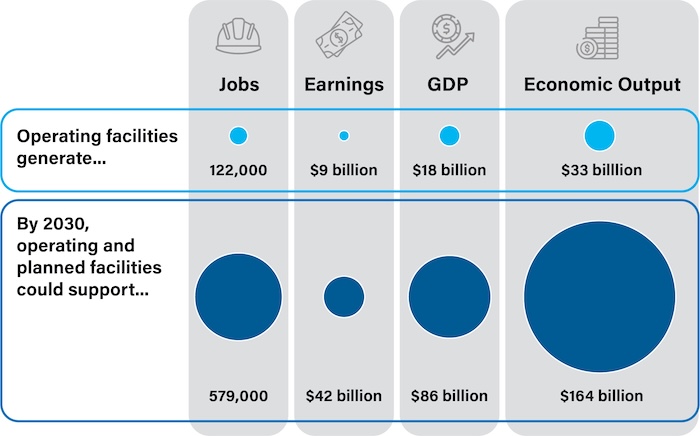NEW REPORT: Clean Energy Manufacturing Driving Next Chapter of U.S. Economic Prosperity
Today at CLEANPOWER 2025, the American Clean Power Association (ACP) released its State of Clean Energy Manufacturing in America report, showing a significant and sustainable ripple effect across states and economic sectors. The clean power manufacturing sector currently contributes $18 billion to U.S. GDP annually, spurs $33 billion in domestic spending annually, and supports 122,000 American jobs across the country.

If all announced manufacturing facilities become operational, clean power manufacturing is projected to support over 575,000 jobs and contribute $86 billion annually to GDP by 2030.
“Surging clean energy deployment is creating new manufacturing facilities across the country. This success will create hundreds of thousands of jobs and revitalize American communities if policy leaders place economic progress over partisan division,” said Jason Grumet, CEO of ACP. “Today’s report shows that the manufacturing activities across the clean energy sector drive a ripple effect of economic growth that extends far beyond factory walls, reaching every corner of the country. Reshoring this critical supply chain requires a shared commitment by both industry and policymakers to prioritize domestic economic growth and global competitiveness.”
Clean Power Manufacturing Driving U.S. Economic Boom
The report illustrates how the industry has laid the groundwork for a secure domestic supply chain, revitalizing manufacturing communities and driving American competition on the global stage.
-
Over 800 manufacturing plants currently contributing to the U.S. clean energy supply chain, with at least one in every state.
-
200 existing manufacturing facilities are actively building primary clean power components across 38 states to supply the booming demand for new energy in America.
Creating Generational Opportunities for Local Communities
New data highlights how clean power manufacturing is creating generational opportunities at the local level, providing opportunities across skillsets, industries, and generating wages well above the national average.
-
Clean energy manufacturing is booming in regions across the country, such as the Southeast, Midwest, and in states like Texas.
-
The clean energy manufacturing workforce made on average $42,000 more than the average worker in the U.S. economy in 2024.
-
These manufacturing jobs also generate additional employment across the economy: Upstream supply chain jobs paid an average of $75,000, while downstream jobs supported by household spending—such as those in retail, food service, and hospitality—averaged about $52,000.
-
Driving US Competitiveness and Global Leadership
The industry’s investments are critical to international competitiveness and innovation, positioning the U.S. as a global leader and strengthening our energy security.
-
America’s power needs are growing fast—projected to rise 35–50% by 2040—as data centers expand, domestic manufacturing rebounds, and our transportation and buildings electrify.
-
Energy manufacturing processes are considerably complex and capital intensive, often requiring multiple intricate steps, specialized equipment, and expertise. This intricacy often comes with trade exposure or a series of imports and exports before the final energy component is ready for installation.
-
A resilient, American-made supply chain for clean energy technologies makes the economy stronger, the country’s energy more secure, and serves as the foundation for innovation and growth.
The Path Forward
There are 200 manufacturing facilities in the pipeline representing over $150 billion of investment. If all announced facilities become operational by 2030, the impact could be transformative.
-
Clean power manufacturing could support over 575,000 jobs
-
Generate over $40 billion in earnings
-
Contribute $86 billion to the GDP
-
Add $164 billion in output to the economy annually
Employment from existing and planned facilities by 2030 by region is projected to be:
-
Northeast: 4,300+
-
Mid-Atlantic: 123,000+
-
South: 172,000+
-
Midwest: 86,000+
-
West: 173,000+
Policy and Business Certainty Critical to American Manufacturing Leadership
The report details how these economic and job benefits have largely been made possible because of federal clean energy tax credits enacted in 2022. The report calls on policymakers to build on this historic American manufacturing legacy with a suite of targeted policy tools to continue the momentum. They include:
-
Preserving energy tax credits (45X, 45Y, 48C, 48E)
-
Creating a stable and strategic trade environment
-
Facilitating a true all-of-the above energy strategy
-
Streamlining permitting to benefit American manufacturers and their customers
-
Ensuring critical minerals policy appropriately leverages demand from downstream domestic clean energy manufacturers.
To read the full report, click here.
American Clean Power Association | cleanpower.org








